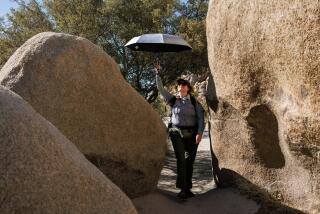Staying relatively safe
- Share via
IF you are in the backcountry or the mountains and cannot seek shelter in an enclosed structure or a vehicle, you should immediately head for lower, safer terrain as soon as thunderclouds begin forming, or you hear thunder. If you can hear thunder, you are close enough to be hit by lightning.
A basic tenet of lightning safety is the “30/30 Rule”: When you see lightning, count out loud until you hear thunder. If it takes 30 seconds or less, seek shelter and stay there for 30 minutes after seeing the last lightning bolt or hearing the last roar of thunder.
The highest objects attract lightning. High, pointed terrain is the worst place to be. Standing on a ridgeline, you are the highest object.
On a mountain, immediately move below the tree line, descending on the side without clouds over it, if possible, because most lightning strikes directly below a cumulonimbus cloud. Avoid open spaces that are more than 300 feet wide, and stay away from lone trees. You are hundreds of times safer in a forest than you are standing next to a tree in an open field. Objects twice as tall are hit four times as often.
If you see lightning, stop moving to safer terrain and assume what the National Weather Service calls the “lightning desperation position” — crouched down, shoes touching, resting on the balls of your feet to minimize exposure to the ground, with your chin on your chest and your hands covering your ears so that the crack of the lightning strike doesn’t damage your eardrums. Members of a group should stay 50 feet apart to avoid multiple injuries.
Do not lie on the ground. Stay away from so-called long conductors such as metal fences, power lines, handrails, bridges and other metal objects. Wet ropes are also excellent conductors and should be avoided.
Empty your pockets of metal and remove belt buckles and jewelry, which will not attract lightning but will, if you are hit, heat up and cause severe burns.
On the water, boaters should head for the shoreline and seek protection as soon as they hear thunder. Boats with cabins can offer protection if you cannot get off the water. In the cabin of a boat, avoid metal objects and electrical components, including the radio. Scuba divers on boats that do not have cabins are safer diving into deep water for the duration of a storm than they are staying on the boat.
The largest single category of lightning fatalities takes place on, in or near water while people are boating, swimming or recreating. Another large category is people seeking shelter under trees, about a third of whom are golfers.
— Vernon Loeb
More to Read
Sign up for The Wild
We’ll help you find the best places to hike, bike and run, as well as the perfect silent spots for meditation and yoga.
You may occasionally receive promotional content from the Los Angeles Times.






